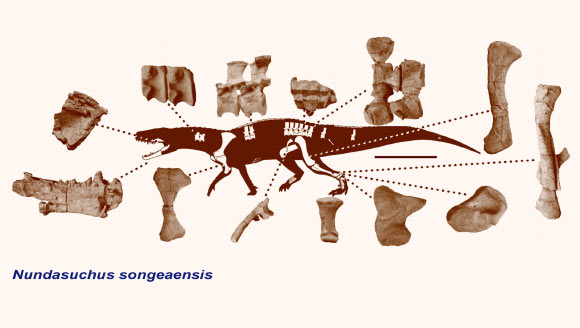A team of paleontologists headed by Dr Sterling Nesbitt of Virginia Tech has described a new genus and species of archosaur that lived in what is today southern Tanzania during the early Middle Triassic, approximately 247 million years ago.

Skeleton of Nundasuchus songeaensis, illustrating the elements found. Scale bar – 50 cm. Image credit: Sterling Nesbitt / Sci-News.com.
The new archosaur, named Nundasuchus songeaensis, is a 2.7-m-long predatory reptile with steak knife-like teeth and bony plates on the back.
The name Nundasuchus songeaensis is Swahili mixed with Greek. “The basic meaning of Nundasuchus is predator crocodile (Nunda meaning predator in Swahili and suchus a reference to a crocodile in Greek),” explained Dr Nesbitt, who is the first author of a paper published in the Journal of Vertebrate Paleontology.
“The songeaensis comes from the town, Songea, near where we found the bones,” he said.
Nundasuchus songeaensis is not a dinosaur, but one of the large reptiles that lived before dinosaurs took over the world.
It was heavy-bodied with limbs under its body like a dinosaur, but with bony plates on its back like a crocodilian.
“Nundasuchus songeaensis represents one of the more complete early Middle Triassic archosaurs from southern Pangea and is part of a previously unrecognized early and diverse archosauriform assemblage.”
“The age of the reptile and the combination of character states that it possesses elucidate a number of interesting points about early archosaur evolution.”
“The archosaur represents a new combination of character states that are not found together in previously known archosauriforms and would not have been predicted by our current vision of archosaur systematics.”
The partial skeleton of the reptile was unearthed in southwestern Tanzania in 2007.
“Although a large number of skeleton bones were found, most of the skull was not recovered despite three trips to the site and more than 1,000 hours spent painstakingly piecing the bones back together and cleaning them,” Dr Nesbitt said.
“There’s such a huge gap in our understanding around the time when the common ancestor of birds and crocodilians was alive – there isn’t a lot out there in the fossil record from that part of the reptile family tree,” he said.
“This helps us fill in some gaps in reptile family tree, but we’re still studying it and figuring out the implications.”
_____
Sterling J. Nesbitt et al. 2014. A new archosaur from the Manda beds (Anisian, Middle Triassic) of southern Tanzania and its implications for character state optimizations at Archosauria and Pseudosuchia. Journal of Vertebrate Paleontology, vol. 34, no. 6; doi: 10.1080/02724634.2014.859622







